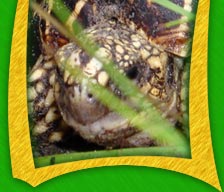|
KEYSTONE SPECIES
Gopher tortoises are significant animals thanks to the important role they
play within Florida’s ecosystem. In the wild, gophers are considered “land-lords” of
the scrub. Their burrows provide food, shelter, and protection for over 300
different species of animals. Maintaining a fairly constant temperature and
level of humidity, these underground burrows are crucial to species such as
the scarab beetle, indigo snake, gopher frog, Florida mouse and armadillo,
just to name a few. Because so much wildlife depends on this animal and its
home, scientists have designated the gopher tortoise a keystone species.
An impact on this creature has a direct effect on its burrow co-inhabitants.
STAYING ALIVE
Having roamed the earth with dinosaurs, turtles are silent keepers
of our past. Florida’s rich ecosystems make for idyllic turtle
habitats, but today’s shelled reptiles are finding fewer
places to live. Loss of habitat remains its greatest threat. Land
that is altered for mining, development, corporate agriculture
and forestry has negative effects on turtle populations. In the
past, developers in Florida could apply for an incidental take
permit if turtles were found on site. The permit allowed developers
to bury tortoises alive, while setting aside funds for the purchase
of turtle-preservation lands elsewhere. Smaller parcels of land
coupled with slow reproductive rates have drastically reduced turtle
populations. As a result, incidental take is no longer permitted
and turtles found on development sites must be relocated to different
locations.
TURTLE TASTES
Despite the resilient nature of turtles, these reptiles face an uphill
battle. Turtle meat is considered a delicacy in many cultures,
and for hundreds of years, hunting turtles for consumption was
common practice in the United States. During the Great Depression, “Hoover
chickens” or Gopher tortoises became a reliable source of
protein for many families in Florida. Other turtles, such as the
water-loving Suwannee cooter (nicknamed Suwannee chicken) and the
Diamondback terrapin have also been exploited for their meat. Also,
gopher races were once a popular form of activity in rural areas.
However, rarely were the animals returned to their original home-ranges,
if released at all. For the lucky few that made it home, they risked
spreading disease and parasites. As a result of these impacts and
more, Gopher tortoise races are no longer allowed in Florida.
DEADLY ROADS
On average, more than 23,000 vehicles traverse U.S. Highway 27 near Tallahassee,
Florida each day, which makes it the world’s
deadliest road for turtles. But, animals aren’t the only
ones at risk. When hit by a car, turtles and other creatures become “dangerous
projectiles” that can cause serious harm to motorists. For
the moment, a silt-material fence is used to direct turtles away
from the road, but conservationists hope the construction of a
permanent guide wall and culvert system along Highway 27 will help
save lives… both human and animal.
Resources for this article
have been provided by the Gopher
Tortoise Council, the Corkscrew
Swamp Sanctuary and the Florida
Fish and Wildlife Conservation Commission.
|











